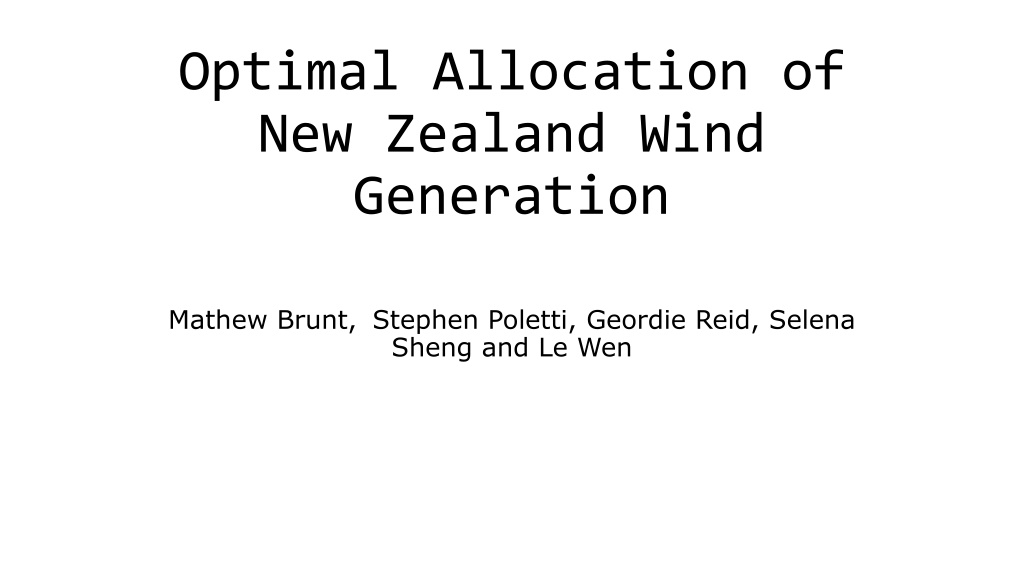Optimal Allocation of New Zealand Wind Generation Study
Investigating the optimal location and quantity of wind generation in New Zealand to achieve a transition to 100% renewable energy by 2050. The study focuses on factors like net demand match, capacity factors, and hour-to-hour variability, utilizing simulated wind output data and considering penalties for generation exceeding or falling short of demand.
Download Presentation

Please find below an Image/Link to download the presentation.
The content on the website is provided AS IS for your information and personal use only. It may not be sold, licensed, or shared on other websites without obtaining consent from the author. Download presentation by click this link. If you encounter any issues during the download, it is possible that the publisher has removed the file from their server.
E N D
Presentation Transcript
Optimal Allocation of New Zealand Wind Generation Mathew Brunt, Stephen Poletti, Geordie Reid, Selena Sheng and Le Wen
Overview Transition to 100% renewable by 2050 in NZ. Demand doubles Means huge amount of wind/solar Here focus on wind. Investigate optimal location and amount of wind. Strategy is to look at a number of factors. 1. Net demand match 2. Capacity factors 3. Hour to hour variability
Wind Resources In NZ Poletti and Steffell (2021) simulated wind output for 31 proposed and possible wind farm sites in New Zealand using NASA data from MERRA. Calibrated against actual historic data.
2050 Scenario (following Transpower) Demand scaled to 70TWh Hydro. Use historic dispatch Geothermal scale up to 1700MW Solar -5900MW (output from Ninja renewables. Distributed on demand population weighted basis (50%) and utility scale (50%))
29 possible wind farms. Least squares Look at half hourly data. No line constraints Then construct loss function for output less than demand. Least cost. If wind generation is greater than net demand: Loss=SUM[Penalty*(wind output_i -net demand_i )] If wind generation is less than net demand: Loss_i=SUM[(net demand_i -wind output_i )] Think of penalty as ratio of LRMC of wind (around $55/MWh) to battery costs (around $200/MWh) We are less worried about too much wind than not enough. Now vary total capacity and locations to minimise loss function Use 3 different penalties {0.1, 0.25, 0.5, 0.75}
Example. Penalty =0.25, 1000GW max have 5 main sites with 1000MW. Total 6560MW
Most frams not included Name Mill Creek Tararua Te Apiti Te Uku West Wind White Hill Castle Hill Kaiwera Downs Maungaharuru Central wind run_0_25_1000 1000 0 0 106.9400839 79.8288401 0 0 0 0 0 Hauauru ma raki Hawkes Bay Mahinerangi Hurunui Puketiro Rototuna Slopedown Turitea Waitahora Hayes Te Waka Mt Munro Cape Campbell Mt Stalker Northland Waipipi 326.3344217 0 0 0 1000 1000 425.7197208 0 0 0 0 63.49273345 350.9329653 205.5713378 1000 1000 TOTAL 6558.820103
Sensitivity Analysis. Vs penalty=0.75 and 0.1 Name Mill Creek Tararua Te Apiti Te Uku West Wind White Hill Castle Hill Kaiwera Downs Maungaharuru Central wind Hauauru ma raki Hawkes Bay Mahinerangi Hurunui Puketiro Rototuna Slopedown Turitea Waitahora Hayes Te Waka Mt Munro Cape Campbell Mt Stalker Northland Waipipi run_0_25_1000run_0_75_1000 run_0_1_1000 1000 771.3231967 0 0 106.9400839 79.8288401 0 0 0 0 0 326.3344217 0 0 0 1000 769.7693975 1000 425.7197208 0 0 0 0 63.49273345 350.9329653 60.69289984 205.5713378 1000 1000 782.2646459 1000 0 0 0 0 0 0 0 0 0 0 0 0 0 0 0 201.4824286 180.6978648 1.479868845 0 0 0 0 632.5029949 0 0 0 1000 1000 1000 0 0 0 0 0 0 985.0823966 0 0 0 0 428.0150581 523.0859472 442.2321481 0 1000 1000 1000 TOTAL 6559 4384 8395
As penalty changes optimum sites are robust but total capacity changes a lot. Also note 1000MW->500MW results RunName 1gw_0_1 1gw_0_25 1gw_0_5 1gw_1 500mw_0_1 500mw_0_25 500mw_0_5 500mw_1 NumSites TotCapacity AvCapacity 14 9981.04 9 7124.61 8 5585.36 6 4278.70 21 10067.39 16 7338.74 13 5578.96 11 4215.49 AvCF PctXS AvXS 712.93 791.62 698.17 713.12 479.40 458.67 429.15 383.23 0.47 0.48 0.49 0.47 0.45 0.46 0.48 0.47 0.81 0.69 0.57 0.44 0.79 0.68 0.56 0.43 2441.08 1203.99 463.28 -218.94 2323.36 1152.80 405.73 -256.75
Capacity factors. Favoured sites good cf but not all good cf favoured Column1 CF te_uku 0.414351529 west_wind 0.4746293 white_hill 0.37677034 0.487013 0.485403384 0.4839952 0.5168106 tararua mill_creek te_apiti waipipi te_rere_hau 0.48979872 mahinerangi 0.415411679 Column2 turitea 0.491216249 mt_cass 0.34833014 0.314954267 0.476376 0.457223773 0.5161568 0.3392007 harapaki kaiwaikawe kaiwera_downs puketoi hurunui central_wind 0.401735129 castle_hill 0.520862629 CF cape_campbell mt_stalker 0.401436002 slopedown mt_munronorthland hayes puketiro hauauru_ma_raki waitahora 0.430468574 rototuna CF 0.350088045 0.473243532 0.509101 0.470619857 0.3759994 0.5080789 0.497822689 0.47711704
Variability (net?) demand work in progress
Conclusions Work in progress but Clearly wind farm in the top of the North Island is important as is geographic spread. Favoured sites incredibly robust to different modelling parameters. Optimal capacity varies a lot. Suggests that battery technology is crucial to least cost
























